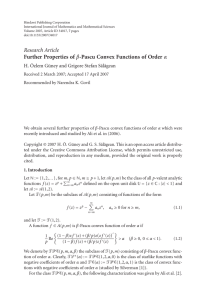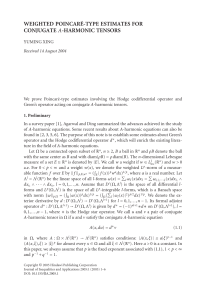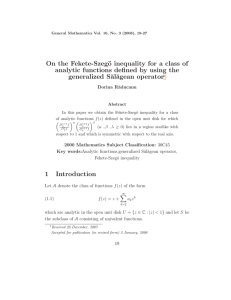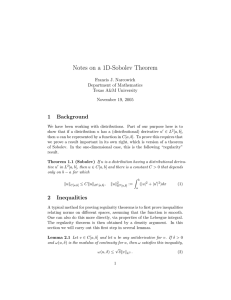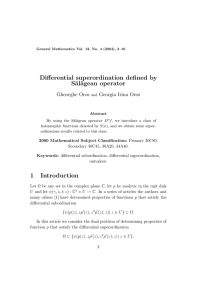COEFFICIENTS ESTIMATES FOR FUNCTIONS IN (α) S. ABDUL HALIM
advertisement
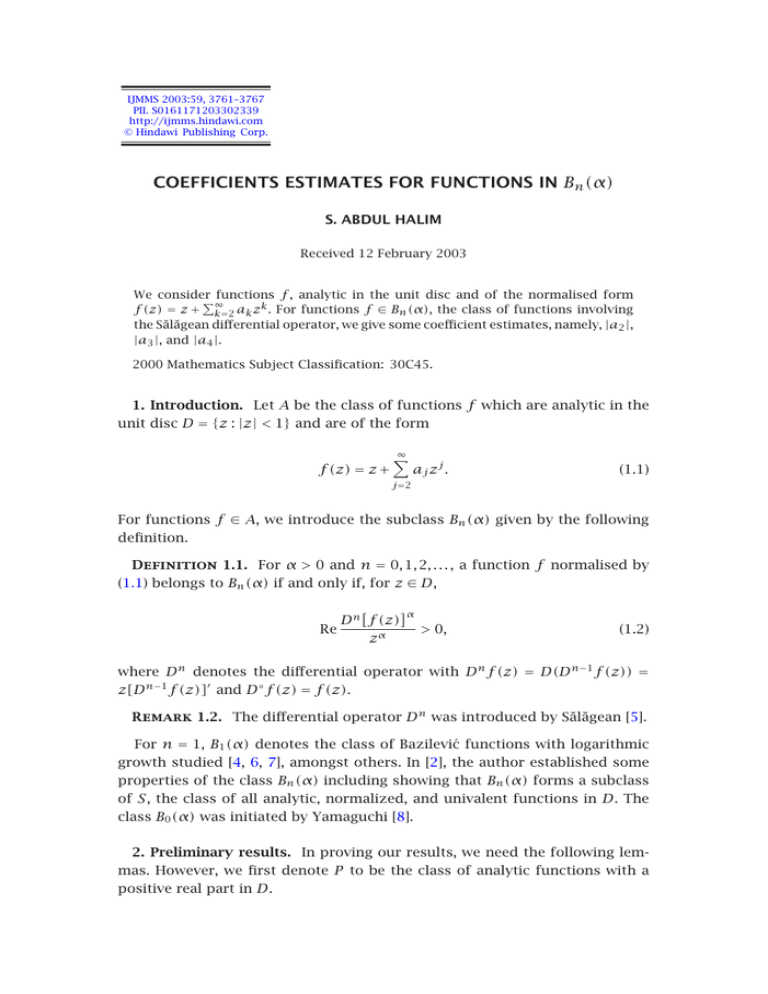
IJMMS 2003:59, 3761–3767
PII. S0161171203302339
http://ijmms.hindawi.com
© Hindawi Publishing Corp.
COEFFICIENTS ESTIMATES FOR FUNCTIONS IN Bn (α)
S. ABDUL HALIM
Received 12 February 2003
We consider functions f , analytic in the unit disc and of the normalised form
k
f (z) = z + ∞
k=2 ak z . For functions f ∈ Bn (α), the class of functions involving
the Sălăgean differential operator, we give some coefficient estimates, namely, |a2 |,
|a3 |, and |a4 |.
2000 Mathematics Subject Classification: 30C45.
1. Introduction. Let A be the class of functions f which are analytic in the
unit disc D = {z : |z| < 1} and are of the form
f (z) = z +
∞
aj zj .
(1.1)
j=2
For functions f ∈ A, we introduce the subclass Bn (α) given by the following
definition.
Definition 1.1. For α > 0 and n = 0, 1, 2, . . . , a function f normalised by
(1.1) belongs to Bn (α) if and only if, for z ∈ D,
Re
α
D n f (z)
> 0,
zα
(1.2)
where D n denotes the differential operator with D n f (z) = D(D n−1 f (z)) =
z[D n−1 f (z)] and D ◦ f (z) = f (z).
Remark 1.2. The differential operator D n was introduced by Sălăgean [5].
For n = 1, B1 (α) denotes the class of Bazilević functions with logarithmic
growth studied [4, 6, 7], amongst others. In [2], the author established some
properties of the class Bn (α) including showing that Bn (α) forms a subclass
of S, the class of all analytic, normalized, and univalent functions in D. The
class B0 (α) was initiated by Yamaguchi [8].
2. Preliminary results. In proving our results, we need the following lemmas. However, we first denote P to be the class of analytic functions with a
positive real part in D.
3762
S. ABDUL HALIM
∞
Lemma 2.1. Let p ∈ P and let it be of the form p(z) = 1 + i=1 ci zi . Then
(i) |ci | ≤ 2 for i ≥ 1,
(ii) |c2 − µc12 | ≤ 2 max{1, |1 − 2µ|} for any µ ∈ C.
∞
∞
Lemma 2.2 (see [3]). If the functions 1+ v=1 bv zv and 1+ v=1 cv zv belong
∞
to P , then the same is true for the function 1 + (1/2) v=1 bv cv zv .
Lemma 2.3 (see [3]). Let h(z) = 1 + h1 z + h2 z2 + · · · and let 1 + g(z) =
1 + g1 z + g2 z2 + · · · be functions in P . Set γ0 = 1 and for v ≥ 1,
γv = 2
−v
v
1 v
hµ .
1+
2 µ=1 µ
(2.1)
If Ak is defined by
∞
∞
v
(−1)v+1 γv−1 g(z) =
Ak z k ,
v=1
(2.2)
k=1
then
Ak ≤ 2.
(2.3)
3. Results
Theorem 3.1. If α > 0, n = 0, 1, 2, . . . , and f ∈ Bn (α) (n is fixed) with f (z) =
∞
z + j=2 aj zj , then the following inequalities hold:
n−1
a2 ≤ 2α
,
(1 + α)n
a3 ≤
n
α2 + 2α
α−1
2αn−1
,
(2 + α)n 1 −
α
α2 + 2α + 1
2αn−1
,
(2 + α)n
(3.1)
for 0 < α < 1,
(3.2)
for α ≥ 1,
2αn−1
(3 + α)n
4(1 − α)α2n−2
(1 − 2α)(2 + α)n αn−1
a4 ≤
+
1+
, for 0 < α < 1,
(1 + α)n (2 + α)n
3(1 + α)2n
2αn−1
,
for α ≥ 1.
(3 + α)n
(3.3)
Remark 3.2. When n = 1, the above results reduce to those obtained by
Singh [6].
COEFFICIENTS ESTIMATES FOR FUNCTIONS IN Bn (α)
3763
Proof. For f ∈ Bn (α), Definition 1.1 gives
Re
D n f (z)α
> 0.
zα
(3.4)
Inequality (3.4) suggests that there exists p ∈ P such that for z ∈ D,
D n f (z)α
= αn p(z).
zα
(3.5)
Next, writing D n f (z)α as z[D n−1 f (z)α ] and p(z) = 1 +
follows that
∞
i=1 ci z
i
in (3.5), it
∞
n−1
α n α−1
i+α−1
f (z)
=α z
+
ci z
D
(3.6)
i=1
and integration gives
∞
ci z i
D n−1 f (z)α
n−1
.
=α
α
1+
zα
(i + α)
i=1
(3.7)
Now, repeating the process, we are able to establish the following relation
which holds in general for any k = 0, 1, 2, . . . , n
∞
i
D n−k f (z)α
c
z
i
.
= αn−k 1 +
αk
zα
(i + α)k
i=1
(3.8)
In particular, when n = k, we have
D 0 f (z)α
=
zα
f (z)
z
α
= 1+
∞
αn
i=1
On comparing coefficients in (3.9) with f (z) = z +
ci z i
.
(i + α)n
∞
j=2 aj z
j
(3.9)
, we obtain
αa2 =
α n c1
,
(1 + α)n
(3.10)
αa3 =
α(1 − α)a22
α n c2
,
+
n
(2 + α)
2
(3.11)
αa4 =
α(1 − α)(α − 2)a32
α n c3
+ α(1 − α)a3 a2 .
+
(3 + α)n
6
(3.12)
Inequality (3.1) follows easily from (3.10) for all α > 0 since |c1 | ≤ 2.
3764
S. ABDUL HALIM
Eliminating a2 in (3.11), we have
αn−1 c2
(1 − α) αn−1 c1 2
+
(2 + α)n
2
(1 + α)n
αn−1
(α − 1) (2 + α)n n−1 2
=
α
c1
c2 −
(2 + α)n
2
(1 + α)2n
a3 =
αn−1 =
c2 − µc12
(2 + α)n
2αn−1
max 1, |1 − 2µ| ,
≤
(2 + α)n
(3.13)
where we used Lemma 2.1(ii) with
2µ =
(α − 1)αn−1 2 + α n
.
(1 + α)n
1+α
(3.14)
Since µ ≥ 0 for α ≥ 1, both inequalities in (3.2) are easily obtained.
We now prove (3.3). Using (3.10) and (3.11) in (3.12) gives
(1 − 2α)αn−1 c13
c1 c2
αn−1
(1 − α)(3 + α)n αn−1
+
c3 +
.
a4 =
(3 + α)n
(1 + α)n
(2 + α)n
6(1 + α)2n
(3.15)
First, we consider the case 0 < α < 1/2. Applying the triangle inequality with
Lemma 2.1(i) in (3.15) results in the inequality
n−1
1
(1 − 2α)αn−1
2(1 − α)(3 + α)n αn−1
a4 ≤ 2α
+
1
+
(3 + α)n
(1 + α)n
(2 + α)n
3(1 + α)2n
(3.16)
which is the first inequality in (3.3).
For the case 1/2 ≤ α < 1, we use Carathéodory-Toeplitz result which states
that for some ε with |ε| < 1,
c12
|c1 |2
+ε 2−
.
c2 =
2
2
(3.17)
Thus, (3.15) becomes
αn−1
(1 − α)(3 + α)n αn−1 c1
c
+
a4 =
3
(3 + α)n
(1 + α)n
2
c1
(1 − 2α)αn−1 c12
2 − |c1 |2
ε
×
+
+
.
2(2 + α)n
6(1 + α)2n
(2 + α)n
2
(3.18)
COEFFICIENTS ESTIMATES FOR FUNCTIONS IN Bn (α)
3765
We then have
a4 ≤
2
2
c1 (1 − α)(3 + α)n αn−1 c1 αn−1
c1
c3 +
,
w
−
ε
+
2ε
n
n
n
(3 + α)
(1 + α) (2 + α)
2
2
(3.19)
where
w = 1+
(1 − 2α)αn−1 (2 + α)n
.
3(1 + α)2n
(3.20)
Since 0 < w ≤ 1 and |ε| < 1, it is easily shown that
a4 ≤
(1 − α)(3 + α)n αn−1 c1 c1 2
αn−1
c 3 +
(w − 1) + 2
(3 + α)n
(1 + α)n (2 + α)n
2
(3.21)
and the result follows trivially when using |c1 | ≤ 2 and |c3 | ≤ 2.
Finally, we consider (3.3) for the case α ≥ 1. Here, we use a method introduced by Nehari and Netanyahu [3] which was also used by Singh [6] and the
author in [1].
First, let h and g be defined as in Lemma 2.3, and since p ∈ P , Lemma 2.2
indicates that
1 + G(z) = 1 +
∞
1
gk ck z k
2 k=1
(3.22)
also belongs to P .
Next, it follows from (2.2) that, with g replaced by G,
1
A 3 = g 3 c 3 − 1 γ 1 g 1 g 2 c 1 c 2 + 1 γ 2 g 3 c 3 .
2
1 1
2
8
(3.23)
Rewriting (3.15) as
α1−n (3 + α)n a4 = c3 +
(1 − α)(3 + α)n αn−1
c1 c2
(1 + α)n (2 + α)n
(1 − α)(1 − 2α)(3 + α)n α2n−2 3
+
c1
6(1 + α)3n
(3.24)
and comparing it with (3.23), the required result is easily obtained since, by
Lemma 2.3, |A3 | = ((3 + α)n /(αn−1 ))|a4 | ≤ 2. This however is only true if we
can show the existence of functions h and ψ in P where ψ(z) = 1 + g(z). To
be simple, we choose ψ(z) = (1+z)/(1−z). Thus, now it remains to construct
and show that an h ∈ P .
3766
S. ABDUL HALIM
Now since g1 = g2 = g3 = 2, it follows from (3.23) and (3.24) that
2γ1 =
γ2 =
(α − 1)(3 + α)n αn−1
,
(1 + α)n (2 + α)n
(3.25)
(1 − α)(1 − 2α)(3 + α)n α2n−2
.
6(1 + α)3n
(3.26)
However, from (2.1), we have
1
1
1 + h1 ,
2
2
1
1
γ2 =
1 + h1 + h2 .
4
2
γ1 =
(3.27)
(3.28)
Solving for h1 by eliminating γ1 from (3.25) and (3.27), we obtain
(α − 1)(3 + α)n αn−1
h1 = 2
.
−
1
(1 + α)n (2 + α)n
(3.29)
Quite trivially, it can be seen that |h1 | ≤ 2 for α ≥ 1.
In a similar manner, eliminating γ2 from (3.26) and (3.28) and using h1 given
by (3.29), we have
n n
1
α2 + 3α
α2 + 2α
2
1 − 2α
h2 = 2 1 −
1−
+3 .
3
α
α2 + 3α + 2
α
α2 + 2α + 1
(3.30)
For α ≥ 1, elementary calculations show that |h2 | ≤ 2.
Next, we construct h by first setting it to be of the form
h(z) =
µ1 (1 − z) µ2 1 + λz2
+
1+z
1 − λz2
(3.31)
with
µ1 = 1 −
(α − 1)(3 + α)n αn−1
,
(1 + α)n (2 + α)n
(α − 1)(3 + α)n αn−1
,
(1 + α)n (2 + α)n
n
1 − 2α
α2 + 2α
2
λ = 1−
+
3
.
3
α
α2 + 2α + 1
µ2 =
(3.32)
It is readily seen that for α ≥ 1, both µ1 and µ2 are nonnegative and µ1 +µ2 =
1. Further, with a little bit of manipulation, it can be shown that |λ| ≤ 1 and
the coefficients of z and z2 in the expansion of h are respectively those given
by (3.29) and (3.30). Hence h ∈ P and thus |a4 | ≤ 2αn−1 /(3 + α)n , the second
inequality in (3.3). This completes the proof of Theorem 3.1.
COEFFICIENTS ESTIMATES FOR FUNCTIONS IN Bn (α)
3767
References
[1]
[2]
[3]
[4]
[5]
[6]
[7]
[8]
S. Abdul Halim, On the coefficients of some Bazilevic functions of order, J. Ramanujan Math. Soc. 4 (1989), no. 1, 53–64.
, On a class of analytic functions involving the Sălăgean differential operator,
Tamkang J. Math. 23 (1992), no. 1, 51–58.
Z. Nehari and E. Netanyahu, On the coefficients of meromorphic schlicht functions,
Proc. Amer. Math. Soc. 8 (1957), 15–23.
M. Obradović, Some results on Bazilevič functions, Mat. Vesnik 37 (1985), no. 1,
92–96.
G. S. Sălăgean, Subclasses of univalent functions, Complex Analysis—Fifth
Romanian-Finnish Seminar, Part 1 (Bucharest, 1981), Lecture Notes in Math.,
vol. 1013, Springer, Berlin, 1983, pp. 362–372.
R. Singh, On Bazilevič functions, Proc. Amer. Math. Soc. 38 (1973), 261–271.
D. K. Thomas, On a subclass of Bazilevič functions, Int. J. Math. Math. Sci. 8 (1985),
no. 4, 779–783.
K. Yamaguchi, On functions satisfying R{f (z)/z} < 0, Proc. Amer. Math. Soc. 17
(1966), 588–591.
S. Abdul Halim: Institute of Mathematical Sciences, University of Malaya, 50603 Kuala
Lumpur, Malaysia
E-mail address: suzeini@um.edu.my


